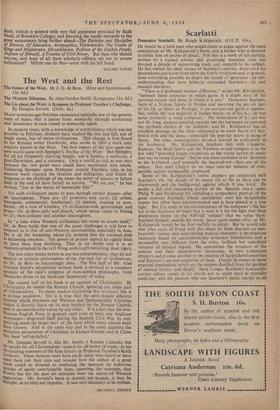Scarlatti
Domenico Scarlatti. By Ralph Kirkpatrick. (O.U.P. 63s.) ' HE would be a bold man who would claim to argue against the main conclusions of Mr. Kirkpatrick's book, and a bolder who ui.dertook to refute him on points of detail. For this is a work of scholarship, written by a trained scholar and practising musician who has devoted a decade of unremitting study and research to his subject. He has visited the chief scenes of Scarlatti's activity, disco., crcd his descendants and learnt from them the family traditions and, in general, done everything possible to dispel the clouds of ignorance nd mis- understanding that have hitherto concealed Scarlatti's rite and musical character.
"There is a profound musical difference," writes Mr. Kirl:patrick, "between those countries in which garlic is a staple itet.i of the national cuisine and those in which it is not." Domenico Scarlatti, born of a Sicilian family in Naples and spending the gm: .ter part of his life in Spain or Portugal, is an out-and-out garlic-c. ,mposer.
But, unlike the vast majority of Italian musia ns of Ins he was never primarily a vocal composer. The foundation of h r, art was not the long, sinuous cantabile melody bnt the harmonic co ours and the rhythmic clashes of the ballabile; and M. Kirkpatr.cl: has an excellent passage on the close relationship between Scud; iti's key- board style and the dance-especially the popular native d. ncing of Spain. No other contemporary devoted himself so exclusively to the keyboard. Mr. Kirkpatrick brackets him with Couperin, Ramcau, the Bach family and the Viennese sonata compos. rs as the few who "provided happy exceptions to the trivial keybo; rd music that was to sweep Europe"; but he was more exclusive in hir devotion to the keyboard—and primarily the harpsichord—than any of the others. Not until Chop'n do we meet another instance of com- parable talents comparably employed. Seven of Mr. Kirkpatrick's twelve chapters are concerned with Scarlatti's life, the details of its course (in so far as thc'e can be discovered) and the background against which it was lived. He paints a full and interesting picture of the Spanish court under Philip V and Ferdinand VI, including a sympathetic portrait of the great castrato Farinelli, whose ascendancy over his. me lancholic master has often been misrepresented and is here placed in a true light. But if a study of the circumstances of the composer's life has led to the discovery of much that is new, it is for the light. that these discoveries throw on the 5C0-edd 'sonatas' that we value them. Scarlatti himself, outside his music, never quite comes alive, as Mr. Kirkpatrick would be the first ruefully to admit. But he would add that after years of living with this music he finds Scarlatti an inex- haustibly various and entertaining musical character, a spc ntarteous innovator based on unexceptionably orthodox foundations and a personality very different from the witty, brilliant but superficial virtuoso of musical legend. He anatomises the structure of the sonatas and their idiosyncratic harmonies in two exhaustive chapters and devotes another to the analysis of harpsichord sonorities and Scarlatti's use and extension of them. Finally he comes to those practical conclusions which are the essence distilled from the gardens of musical history and theory. Here Longo, Scarlatti's nineteenth- century editor, comes in for words not so much hard as mortally moderate; and the pianists who use Scarlatti's music merely as an excuse for demonstrating their finger-agility are the more firmly relegated to outer darkness by the author's admission that he, too, has been guilty of the same total misunderstanding of this music in the past.
The book is excellently printed and produced, with impressive apparatus criticus, a sufficient number of well chosen music-type examples and some attractive reproductions of eighteenth-century drawings and portraits.
MARTIN COOPER



































 Previous page
Previous page